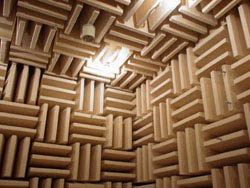Architectural acoustics
Architectural acoustics is the science and engineering of achieving a good sound within a building. It involves the study of how sound interacts with the built environment. The goal of architectural acoustics is to create spaces that are suitable for various uses, ranging from concert halls that require excellent sound quality to office buildings that need to minimize noise pollution. This field combines elements of acoustics, architecture, physics, and engineering to understand and manipulate sound behavior in enclosed spaces.
History[edit | edit source]
The study of architectural acoustics can be traced back to ancient civilizations, where large amphitheaters and auditoriums were designed to enhance the audience's listening experience. However, the formal study of architectural acoustics began in the late 19th and early 20th centuries with the work of Wallace Clement Sabine. Sabine, considered the father of architectural acoustics, developed the Sabine equation, which quantifies the relationship between the physical characteristics of a room, its absorption, and its reverberation time.
Principles[edit | edit source]
The principles of architectural acoustics revolve around three main concepts: sound absorption, sound reflection, and sound diffusion.
- Sound Absorption involves the use of materials and surfaces that absorb sound energy instead of reflecting it. This is crucial in reducing echo and reverberation in a room.
- Sound Reflection is the phenomenon where sound bounces off surfaces. Strategic placement of reflective surfaces can enhance sound quality in a space.
- Sound Diffusion is the even distribution of sound throughout a space. Diffusive surfaces scatter sound waves, reducing the focus of sound energy in any one direction.
Applications[edit | edit source]
Architectural acoustics finds applications in various fields, including:
- Concert Halls and Theaters: Designing spaces with optimal acoustics for music and live performances.
- Recording Studios: Creating environments that capture sound accurately without external noise or unwanted echoes.
- Offices and Commercial Buildings: Implementing soundproofing techniques to minimize noise pollution and enhance speech privacy.
- Educational Facilities: Designing classrooms and lecture halls that support clear communication and learning.
Challenges[edit | edit source]
One of the main challenges in architectural acoustics is managing the trade-offs between aesthetics and functionality. Architects and acousticians must work together to integrate acoustic solutions that do not compromise the visual design of a space. Additionally, each space has unique acoustic requirements, making it necessary to customize solutions for each project.
Technological Advances[edit | edit source]
Advancements in technology have significantly impacted architectural acoustics. Computer modeling and simulation tools allow for the virtual testing of acoustic designs before they are implemented. Materials science has also contributed to the development of new sound-absorbing and sound-reflecting materials.
Conclusion[edit | edit source]
Architectural acoustics plays a critical role in the design of buildings and spaces, ensuring that they meet the specific sound requirements of their intended use. Through the application of scientific principles and technological innovations, architects and acousticians can create environments that enhance the auditory experience.
Search WikiMD
Ad.Tired of being Overweight? Try W8MD's physician weight loss program.
Semaglutide (Ozempic / Wegovy and Tirzepatide (Mounjaro / Zepbound) available.
Advertise on WikiMD
|
WikiMD's Wellness Encyclopedia |
| Let Food Be Thy Medicine Medicine Thy Food - Hippocrates |
Translate this page: - East Asian
中文,
日本,
한국어,
South Asian
हिन्दी,
தமிழ்,
తెలుగు,
Urdu,
ಕನ್ನಡ,
Southeast Asian
Indonesian,
Vietnamese,
Thai,
မြန်မာဘာသာ,
বাংলা
European
español,
Deutsch,
français,
Greek,
português do Brasil,
polski,
română,
русский,
Nederlands,
norsk,
svenska,
suomi,
Italian
Middle Eastern & African
عربى,
Turkish,
Persian,
Hebrew,
Afrikaans,
isiZulu,
Kiswahili,
Other
Bulgarian,
Hungarian,
Czech,
Swedish,
മലയാളം,
मराठी,
ਪੰਜਾਬੀ,
ગુજરાતી,
Portuguese,
Ukrainian
Medical Disclaimer: WikiMD is not a substitute for professional medical advice. The information on WikiMD is provided as an information resource only, may be incorrect, outdated or misleading, and is not to be used or relied on for any diagnostic or treatment purposes. Please consult your health care provider before making any healthcare decisions or for guidance about a specific medical condition. WikiMD expressly disclaims responsibility, and shall have no liability, for any damages, loss, injury, or liability whatsoever suffered as a result of your reliance on the information contained in this site. By visiting this site you agree to the foregoing terms and conditions, which may from time to time be changed or supplemented by WikiMD. If you do not agree to the foregoing terms and conditions, you should not enter or use this site. See full disclaimer.
Credits:Most images are courtesy of Wikimedia commons, and templates, categories Wikipedia, licensed under CC BY SA or similar.
Contributors: Prab R. Tumpati, MD



